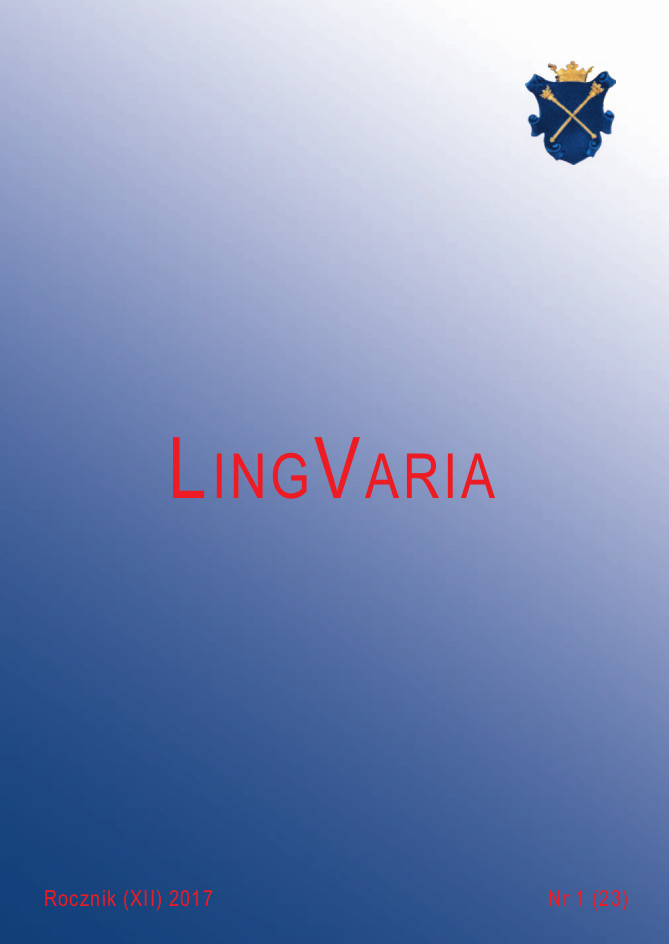Pidżyny i inne języki wehikularne
DOI:
https://doi.org/10.12797/LV.12.2017.23.02Słowa kluczowe:
język wehikularny, pidżyn, lingua franca, sabirAbstrakt
Pidgins and Other Vehicular Languages
Vehicular languages are languages which are used as a mean of communication in multicultural and multilingual societies; therefore the key to understanding the essence of vehicular languages is to analyse linguistic contact. The purpose of this study is to analyse such vehicular languages as: pidgin, lingua franca, and sabir, as well as to present the similarities and differences between them. An additional goal is to show the different types of vehicular languages which were used all around the world.
Pobrania
Bibliografia
Bakker P., 1995, Pidgins, [w:] J. Arends, P. Muysken, N. Smith (red.), Pidgins and creoles: an introduction, Amsterdam – Philadelphia, s. 25–39.
Baxter A.N., 1996, Portuguese in the Pacific and Pacific Rim, [w:] S.A. Wurm, P. Mühlhäusler, D.T. Tryon (red.), Language atlas for intercultural communication in the Pacific Rim area, Berlin, s. 299–338.
Bickerton D., 1990, Language and species, Chicago.
Blanke D., 1985, Internationale Plansprachen: eine Einführung, Berlin.
Bloomfield L., 1933, Language, New York.
Bollée A., 1977, Pidgins und kreolische Sprachen, „Studium Linguistik” 3, s. 48–76.
Chaudenson R., 1979, Les créoles français, Paris.
Cifoletti G., 1989, La lingua franca mediterranea, Pádua.
Clements J.C., 1999, Evidência para a existência de um pidgin português asiático, [w:] E. d’Andrade, D. Pereira, M.A. Mota (red.), Crioulos de base portuguesa, Lisboa, s. 185–201.
Collier B., 1976, On the origins of Lingua Franca, „Journal of Creole Studies” 1 (2), s. 281–298.
Couto H.H., 1996, Introdução ao estudo das língua crioulas e pidgins, Brasília.
Couto H.H., 2002, A Língua Franca Mediterrânea: histórico, textos e interpretação, Brasília.
EJO: K. Polański (red.), Encyklopedia językoznawstwa ogólnego, wyd. 2 popr. i uzup., Wrocław – Warszawa – Kraków 1999.
Granda G., 1978, Estudios lingüisticos hispánicos, afrohispánicos y criollos, Madrid.
Hall R. Jr., 1962, The life-cycle of pidgin languages, „Lingua” 78, s. 151−156.
Hall R. Jr., 1966, Pidgin and creole languages, Ithaca.
Hancock I., 1977, Recovering pidgin genesis: approaches and problems, [w:] A. Valdman (red.), Pidgins and creoles linguistics, Indiana, s. 277–294.
Hlibowicka-Węglarz B., 2016, Śródziemnomorska lingua franca jako jeden z najstarszych pidginów, [w:] A. Krzyżanowska, M. Posturzyńska-Bosko, P. Sorbet (red.), Badania diachroniczne w Polsce II. Między współczesnością a przeszłością, Lublin, s. 11–24.
Holm J., 1989, Pidgins and creoles, t. 2, Cambridge.
Hymes D. (red.), 1971, Pidginization and creolization of languages, Cambridge.
Jespersen O., 1922, Language, its nature, development and origin, London.
Meisel J.M., 1975, Ausländerdeutsch und Deutsch ausländischer Arbeiter, zur möglichen Entstehung eines Pidgin in der BRD, „Zeitschrift für Literaturwissenschaft und Linguistic” 5 (18), s. 9–53.
Mühlhäusler P., 1986, Pidgin and creole linguistic, Oxford.
Perego P., 1968, Les sabirs, [w:] A. Martinet (red.), Le langage – Encyclopédie de la Pléiade, Paris, s. 597–607.
Pereira D., 2002, A linguagem dos escravos negros em Portugal – entre a realidade e a ficção, [w:] I. de Castro Henriques (red.), Escravatura e transformações culturais. África – Brasil – Caraíbas, Evora.
Pereira D., 2006, Crioulos de base portuguesa, Lisboa.
Reinecke J.E., 1937/1986, Marginal languages: A sociological survey of the creole languages and trade jargons, Yale University, rozprawa doktorska.
Samarin W., 1968, Lingua francas of the world, [w:] J. Fishman (red.), Readings in the sociology of language, The Hague – Paris – Mouton, s. 660–672.
Samarin W., 1971, Salient and substantive pidginization, [w:] D. Hymes (red.), Pidginization and creolization of languages, Cambridge, s. 117–140.
Schuchardt H., 1909, Die Lingua Franca, „Zeitschrift für romanische Philologie” 33, s. 441–461.
Schuman J.H., 1978, Second language acquisition: The pidginization hypotesis, [w:] E. Hatch (red.), Second language acquisition: A book of readings, Rowley, s. 256–271.
Stewart W., 1962, Creole languages in the Caribbean, [w:] F.A. Rice (red.), Study of the role of second languages in Asia, Africa, and Latin America, Washington, s. 34–53.
Thomason S.G., 1997, A typology of contact languages, [w:] A.K. Spears, D. Winford (red.), The structure and status of pidgins and creoles, Amsterdam – Philadelphia, s. 71–88.
Thomason S.G., Kaufman T., 1988, Language contact, creolization and genetic linguistics, Berkeley.
Thompson R.W., 1961, A note on some possible affinities between the creole dialects of the Old World and those of the New, „Creole Language Studies” 2, s. 107–113.
Valdman A., 1978, Le créole: structure, statut et origine, Paris.
Valkhoff M. (red.), 1975, Miscelânia Luso-Africana. Colectânea de Estudos Coligidos, Lisboa.
Whinnom K., 1965, The origin of the European-besed creoles and pidgins, „Orbis” 14 (2), s. 509–527.
Whinnom K., 1971, Linguistic hybridization and the special case of pidgins and creoles, [w:] D. Hymes (red.), Pidginization and creolization of languages, Cambridge.
Whinnom K., 1977, The context and origin of Lingua Franca, [w:] J. Meisel (red.), Langues in contact – Pidgins – Creoles, Tübingen, s. 3–18.
Pobrania
Opublikowane
Numer
Dział
Licencja
Prawa autorskie (c) 2017 Barbara Hlibowicka-Węglarz

Utwór dostępny jest na licencji Creative Commons Uznanie autorstwa – Użycie niekomercyjne – Bez utworów zależnych 4.0 Międzynarodowe.






